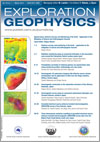
Exploration Geophysics
Volume 45 Number 1 2014
Airborne Surveys and Monitoring of the Earth - Application to the Mitigation of Natural and Anthropogenic Hazards
EGv45n1_EDAirborne surveys and monitoring of the Earth – application to the mitigation of natural and anthropogenic hazards
Airborne surveys are highly useful for their capacity to map, monitor, and forecast natural and anthropogenic hazards safely and efficiently from the air, and for understanding the Earth’s global structures. This special issue is based on papers presented at a session of the Japan Geoscience Union Meeting 2012 which was held on 23 May 2012 in Chiba, Japan.
EG13004Radiation monitoring using an unmanned helicopter in the evacuation zone around the Fukushima Daiichi nuclear power plant
We developed a radiation monitoring system using unmanned helicopters. We then measured the radiation level by using unmanned helicopters in areas where the soil had been contaminated by radioactive caesium emitted from the Fukushima Daiichi nuclear power plant to evaluate the ambient dose rate distribution around the site.
EG12075Precipitation correction of airborne gamma-ray spectrometry data using monitoring profiles: methodology and case study
Variations of soil moisture content caused by precipitation often complicate the interpretation of airborne gamma-ray spectrometry data. Based on repeated survey flights over a monitoring profile, which is representative for the survey area in terms of weather and soil conditions, the effect of precipitation can be observed and sufficiently corrected.
EG13022Aeromagnetic 3D subsurface imaging with effective source volume minimisation and its application to data from the Otoge cauldron, Shitara, Central Japan
Aeromagnetic 3D subsurface imaging in rugged terrain using the conjugate gradient solution is discussed. Based on the examinations of parameter scaling and regularisation methods, the compact regularisation method for the variable-volume elements model was successfully applied to the data of the Otoge cauldron, Central Japan.
EG13041Aeromagnetic constraints on the subsurface structure of Usu Volcano, Hokkaido, Japan
We conducted 3D imaging of magnetic anomalies of Usu Volcano, Japan, observed right after the 2000 eruption. However, no information about magmas intruded during the recent eruptions was obtained. Perhaps the intruded magmas had not cooled enough to become strongly magnetised by the time the survey was conducted.
EG12087Aeromagnetic survey using an unmanned autonomous helicopter over Tarumae Volcano, northern Japan
We conducted an aeromagnetic survey over a volcano using an unmanned autonomous helicopter. With its high accuracy of positioning control in autonomous flight and small field gradient in the air, detection of temporal changes of an order of 10 nT may be feasible through a direct comparison between separate surveys.
EG12074Grounded electrical-source airborne transient electromagnetics (GREATEM) survey of Aso Volcano, Japan
GREATEM, a type of semi-airborne electromagnetics, was used to examine Aso Volcano to verify its applicability to surveying deep subsurface resistivity structures. Comparison of the GREATEM results with those of ground-based TEM and repeated GREATEM surveys indicated that GREATEM can successfully identify underground structures as deep as ~800 m.
EG12086Three-dimensional resistivity modelling of grounded electrical-source airborne transient electromagnetic (GREATEM) survey data from the Nojima Fault, Awaji Island, south-east Japan
A GREATEM system survey was conducted over the Nojima Fault on Awaji Island, Japan, to assess GREATEM survey applicability for studying coastal areas with complex topographic features. 1D inversion results were not reasonable in that the horizontal resistivity values were greatly changed. To circumvent this problem, we performed numerical forward modelling to generate a 3D resistivity structure model from the GREATEM data of the Nojima Fault area.

